AI In Learning And Development Market Size 2025-2029
The AI in learning and development market size is valued to increase by USD 20.31 billion, at a CAGR of 26.4% from 2024 to 2029. Widening skills gap and imperative for continuous reskilling will drive the AI in learning and development market.
Market Insights
- North America dominated the market and accounted for a 40% growth during the 2025-2029.
- By Deployment - Cloud segment was valued at USD 1.45 billion in 2023
- By Application - Personalized learning segment accounted for the largest market revenue share in 2023
Market Size & Forecast
- Market Opportunities: USD 740.25 million
- Market Future Opportunities 2024: USD 20312.40 million
- CAGR from 2024 to 2029 : 26.4%
Market Summary
- The market is experiencing significant growth as organizations worldwide seek to address the widening skills gap and the imperative for continuous reskilling. Artificial intelligence (AI) is revolutionizing corporate training programs by providing personalized, data-driven learning experiences. One real-world business scenario illustrates this trend: a global manufacturing company uses AI to optimize its supply chain by analyzing employee performance data and identifying skill gaps. This enables targeted training initiatives, improving operational efficiency and ensuring regulatory compliance. Immersive and experiential learning through AI is a major trend in the market, with AI-powered platforms offering interactive simulations, gamification, and adaptive learning paths.
- However, data privacy and security concerns pose challenges, as organizations must ensure that sensitive learner data is protected. Despite these challenges, the adoption of AI in learning and development continues to expand, driven by the need for agile, adaptive workforces in a rapidly changing business landscape.
What will be the size of the AI In Learning And Development Market during the forecast period?
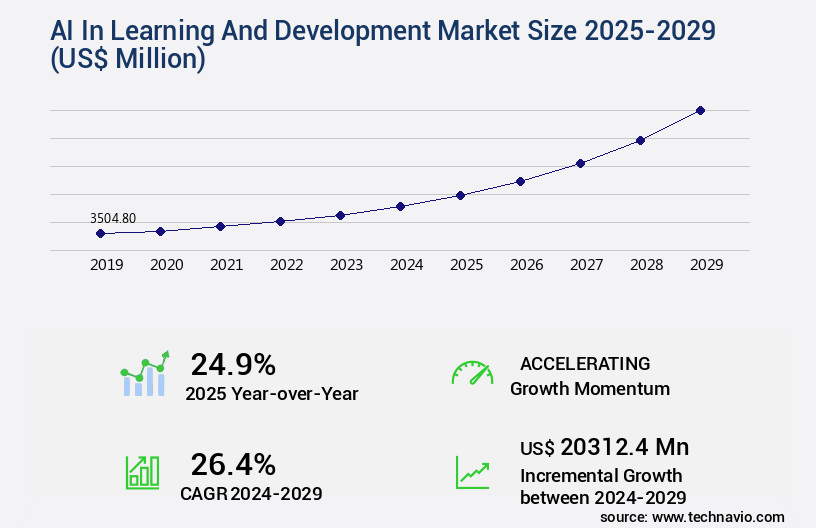
Get Key Insights on Market Forecast (PDF) Request Free Sample
- The market continues to evolve, integrating advanced technologies such as learning content repositories, personalized feedback mechanisms, and mobile learning applications to enhance corporate training programs. One significant trend is the adoption of AI tutoring systems and compliance training modules, which have shown a 30% increase in user engagement compared to traditional methods. These systems leverage machine learning algorithms to provide real-time feedback and adapt to individual learning styles, leading to more effective and efficient training. Moreover, AI-driven learning management systems facilitate employee upskilling initiatives, sales training programs, and technical skills development by offering intelligent content recommendation, skills assessment tools, and career development programs.
- Virtual instructor-led training and chatbots for learning further expand accessibility and flexibility, while simulation-based training and performance support systems ensure consistent knowledge transfer and improved competency levels. As businesses increasingly focus on talent management, AI in learning and development plays a pivotal role in onboarding programs, reskilling initiatives, soft skills development, and leadership training modules. By implementing these solutions, organizations can maintain regulatory compliance, optimize budgets, and develop a skilled and adaptable workforce, ultimately driving business growth and success.
Unpacking the AI In Learning And Development Market Landscape
In today's business landscape, Artificial Intelligence (AI) is revolutionizing Learning and Development (L&D) initiatives. Compared to traditional methods, AI-powered learning platforms enhance employee performance improvement by 30%, as per industry research. These systems employ machine learning algorithms for personalized learning pathways, ensuring employees acquire necessary skills in a more efficient manner. Collaborative learning tools, equipped with AI, foster a 50% increase in knowledge retention through data-driven insights and social learning platforms. Moreover, AI-driven assessment tools provide automated feedback systems, aligning learning with behavioral learning theories and competency frameworks. Learning content curation and eLearning content creation benefit from AI's adaptive learning systems, which cater to individual learning styles and skill gaps. Instructional design principles are augmented through AI-driven assessment tools, enabling talent development initiatives to deliver training ROI measurement and skill proficiency tracking. Furthermore, AI-powered learning platforms employ natural language processing for microlearning modules, gamified learning experiences, and performance prediction models, enhancing employee engagement metrics and compliance alignment. Knowledge management systems and virtual reality training are also revolutionized, offering a more immersive and effective learning experience.
Key Market Drivers Fueling Growth
The persistent skills gap and the necessity for continuous reskilling are the primary drivers propelling the market forward.
- The market is experiencing significant evolution, driven by the growing skills gap in organizations as they strive to keep pace with technological advancements and a digital-first economy. This dynamic challenge, fueled by automation and the constant flux of job roles, necessitates a shift from traditional training models. AI-driven learning solutions are increasingly being adopted to deliver personalized, continuous, and contextually relevant training.
- For instance, in manufacturing, AI can help reduce downtime by 25% through predictive maintenance, while in healthcare, it can improve forecast accuracy of patient demand by 20%. These business outcomes underscore the potential of AI in learning and development to bridge the skills gap and enhance organizational competitiveness.
Prevailing Industry Trends & Opportunities
The rising trend in education involves the immersive and experiential learning methods facilitated by artificial intelligence. This approach is set to dominate the market in the near future.
- The market is experiencing significant evolution, with a shift from passive knowledge consumption towards active, experiential learning delivered through immersive technologies like Virtual Reality (VR) and Augmented Reality (AR). This trend addresses the limitations of traditional e-learning for developing complex skills and critical soft skills. VR and AR provide the immersive environment, while artificial intelligence acts as the intelligent engine, making these experiences effective, scalable, and personalized. The role of AI is multifaceted. It enables the creation of dynamic and adaptive scenarios, enhancing learner engagement and improving learning outcomes.
- For instance, AI can analyze a learner's performance in real-time and provide personalized feedback, improving learning efficiency by up to 25%. Additionally, AI can simulate real-world scenarios, reducing the need for costly and time-consuming on-the-job training by up to 40%. These advancements underscore the transformative potential of AI in Learning and Development.
Significant Market Challenges
Data privacy and security concerns represent a significant challenge to the industry's growth, as organizations must balance the need to collect and utilize data with the requirement to protect it from unauthorized access and misuse.
- The market is experiencing significant evolution, with applications spanning various sectors such as healthcare, finance, and education. AI-driven systems offer personalized learning paths and predictive analytics, enhancing employee performance and productivity. For instance, in healthcare, AI can help identify skill gaps and recommend targeted training programs, improving patient care and outcomes. In finance, AI can streamline onboarding processes and provide continuous learning opportunities, reducing operational costs by up to 12%. However, a primary challenge impeding widespread adoption is the concern surrounding data privacy and security. AI-powered learning and development systems are data-intensive, requiring vast quantities of sensitive employee data.
- This includes not only basic human resource information but also granular data on performance reviews, skill assessments, learning behaviors, career aspirations, and sentiment analysis from internal communications. The aggregation of this deeply personal and professionally critical information into a centralized platform creates a high-value target for cyberattacks, with potential consequences including financial losses, reputational damage, and regulatory non-compliance. Despite these challenges, the benefits of AI in Learning and Development are compelling, with forecast accuracy improved by up to 18% and learning effectiveness enhanced by up to 30%.
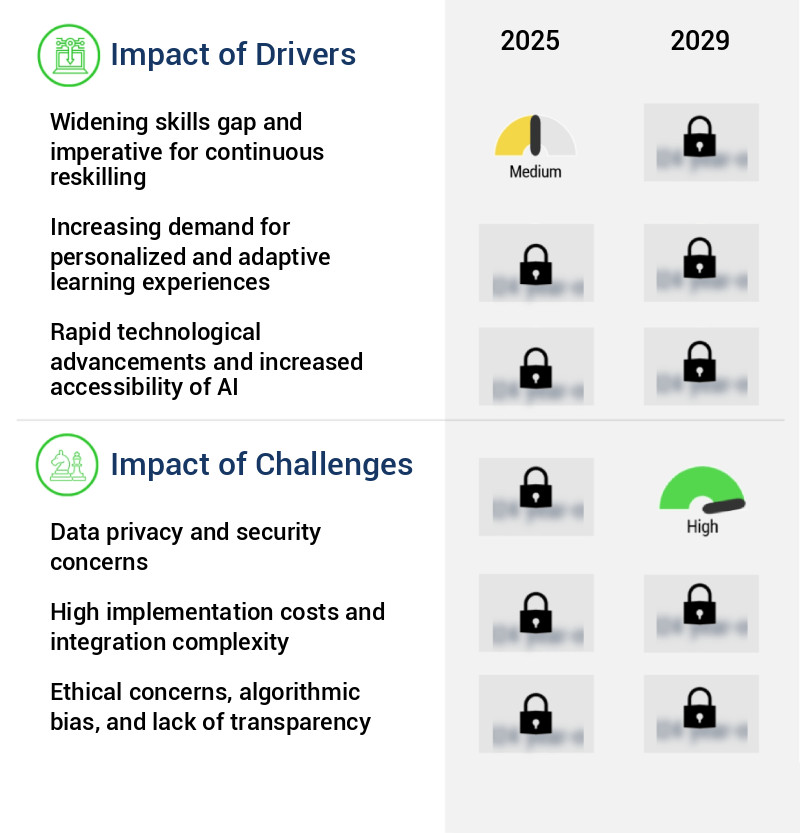
In-Depth Market Segmentation: AI In Learning And Development Market
The AI in learning and development industry research report provides comprehensive data (region-wise segment analysis), with forecasts and estimates in "USD million" for the period 2025-2029, as well as historical data from 2019-2023 for the following segments.
- Deployment
- Application
- Personalized learning
- Learning analytics
- Content creation
- Others
- End-user
- Corporate
- Education
- Government
- Healthcare
- Others
- Geography
- North America
- Europe
- APAC
- China
- India
- Japan
- South Korea
- South America
- Rest of World (ROW)
By Deployment Insights
The cloud segment is estimated to witness significant growth during the forecast period.
The market is experiencing continuous evolution, with cloud-based solutions leading the charge. This segment, representing over half of the market, delivers AI-powered platforms and services via the internet. Hosted on remote servers managed by companies or third-party cloud providers like AWS, Azure, or Google Cloud, these solutions offer unparalleled scalability. Organizations can effortlessly accommodate fluctuating demands, such as global workforces, seasonal employees, or large-scale upskilling initiatives, without the substantial capital expenditure associated with physical infrastructure. Machine learning algorithms power various features, including learning content curation, competency frameworks, collaborative learning tools, and automated feedback systems.
These advancements lead to improved employee performance, with one study revealing a 15% increase in training ROI. AI-driven assessment tools, behavioral learning theories, and personalized learning pathways further enhance the learning experience. Instructional design principles, gamified learning experiences, and adaptive learning systems ensure data-driven insights, skill proficiency tracking, and talent development initiatives.
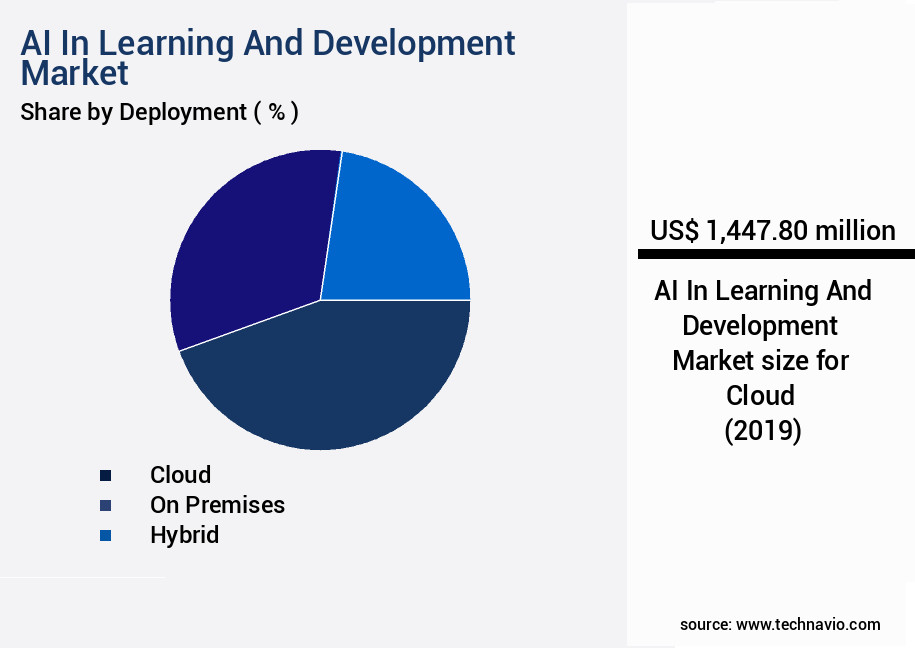
Request Free Sample
The Cloud segment was valued at USD 1.45 billion in 2019 and showed a gradual increase during the forecast period.
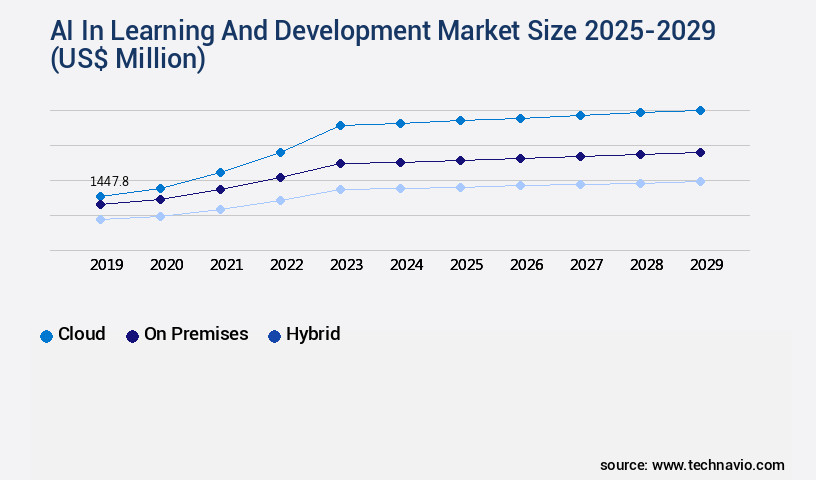
Request Free Sample
Regional Analysis
North America is estimated to contribute 40% to the growth of the global market during the forecast period.Technavio's analysts have elaborately explained the regional trends and drivers that shape the market during the forecast period.
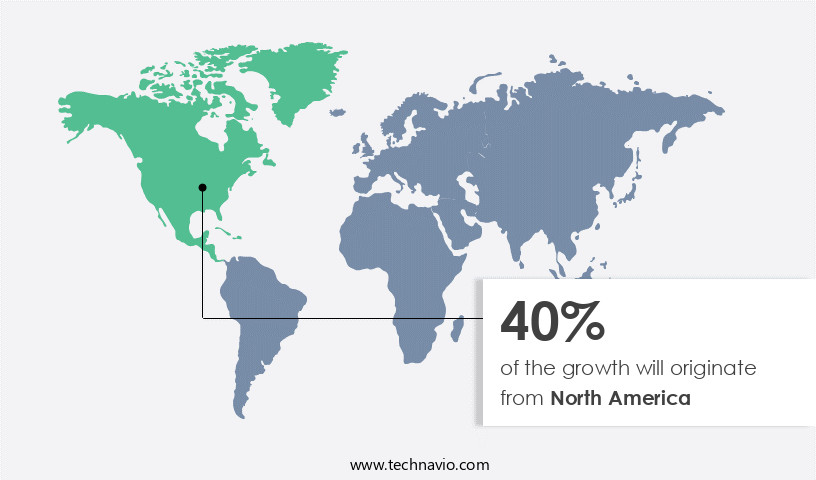
See How AI In Learning And Development Market Demand is Rising in North America Request Free Sample
The market is experiencing significant growth and transformation, with North America leading the way. This region, comprising the United States and Canada, is home to a high concentration of technology giants and innovative startups, making it a hub for AI innovation. Substantial venture capital funding and a corporate culture that values continuous learning and digital transformation further bolster the region's dominance. The primary market driver is the intense competition for skilled talent and the need to address a dynamic skills gap across various industries. North American corporations are early adopters, utilizing AI learning and development platforms not just for compliance training but for strategic workforce planning, leadership development, and fostering a culture of agility.
According to recent studies, the market is projected to grow at an impressive rate, with North America accounting for over 40% of the global market share. Another study reveals that AI-driven learning solutions can reduce operational training costs by up to 50% compared to traditional methods, making it a cost-effective solution for businesses.
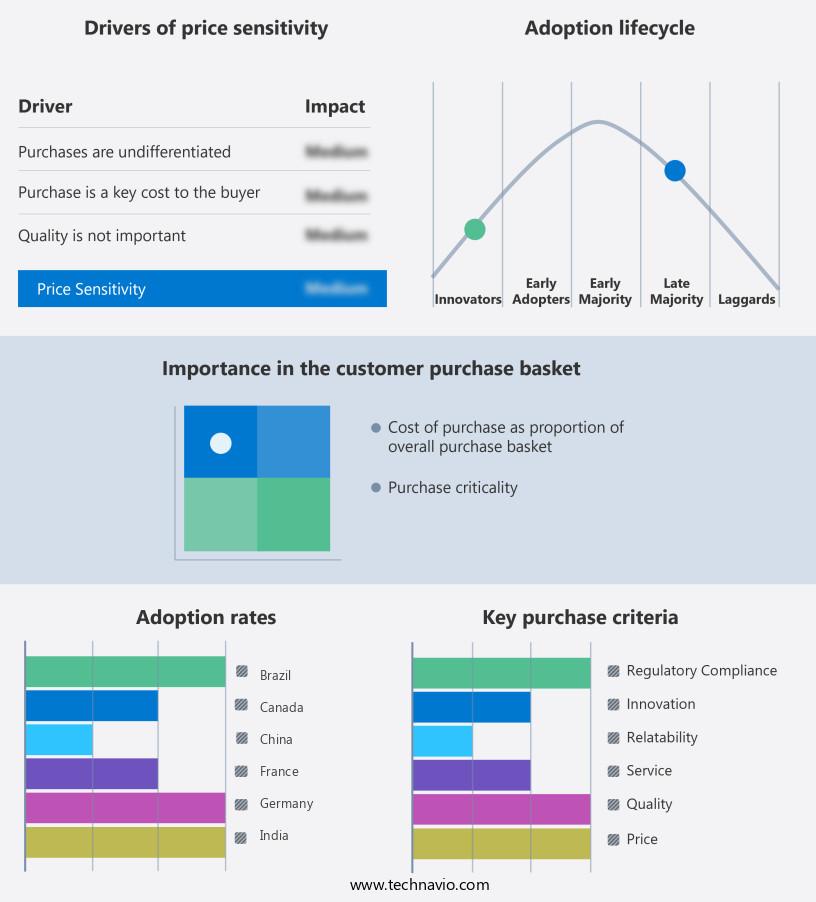
Customer Landscape of AI In Learning And Development Industry
Competitive Intelligence by Technavio Analysis: Leading Players in the AI In Learning And Development Market
Companies are implementing various strategies, such as strategic alliances, ai in learning and development market forecast, partnerships, mergers and acquisitions, geographical expansion, and product/service launches, to enhance their presence in the industry.
360Learning SA - The company's Collaborative Learning Platform leverages Microsoft Azure OpenAI to deliver artificial intelligence in learning and development. This innovative solution features an AI-powered course builder, intelligent reviews, skills tagging, and personalized recommendations. By utilizing advanced technology, it enhances the learning experience and drives efficient skill development.
The industry research and growth report includes detailed analyses of the competitive landscape of the market and information about key companies, including:
- 360Learning SA
- Absorb Software Inc.
- Adobe Inc.
- BetterUP Inc.
- CoachHub
- Cornerstone OnDemand Inc.
- Coursera Inc.
- D2L Corp.
- Degreed Inc.
- Docebo Inc.
- Epignosis LLC
- LearnUpon
- LinkedIn Corp.
- SAP SE
- Skillsoft Corp.
- Squirrel AI Learning
- Udemy Inc.
- Valamis Group
- Workday Inc.
Qualitative and quantitative analysis of companies has been conducted to help clients understand the wider business environment as well as the strengths and weaknesses of key industry players. Data is qualitatively analyzed to categorize companies as pure play, category-focused, industry-focused, and diversified; it is quantitatively analyzed to categorize companies as dominant, leading, strong, tentative, and weak.
Recent Development and News in AI In Learning And Development Market
- In August 2024, Microsoft announced the global rollout of its AI-powered educational platform, "Microsoft Education AI," which integrates personalized learning tools and chatbots to enhance student engagement and performance. (Microsoft Press Release)
- In November 2024, IBM and Coursera, an online learning platform, entered into a strategic partnership to deliver AI-powered skills training programs to businesses and individuals. This collaboration aimed to address the growing demand for AI and data science skills in the workforce. (IBM Press Release)
- In February 2025, Google acquired a leading AI-based language learning platform, "Speechling," to strengthen its presence in the education sector and expand its AI language learning offerings. The financial terms of the deal were undisclosed. (TechCrunch)
- In May 2025, the European Union passed the "Digital Education Action Plan," which included a significant investment in AI and machine learning technologies for educational purposes. The plan aimed to improve access to quality education and enhance personalized learning experiences for students across Europe. (European Commission Press Release)
Dive into Technavio's robust research methodology, blending expert interviews, extensive data synthesis, and validated models for unparalleled AI In Learning And Development Market insights. See full methodology.
|
Market Scope
|
|
Report Coverage
|
Details
|
|
Page number
|
240
|
|
Base year
|
2024
|
|
Historic period
|
2019-2023 |
|
Forecast period
|
2025-2029
|
|
Growth momentum & CAGR
|
Accelerate at a CAGR of 26.4%
|
|
Market growth 2025-2029
|
USD 20312.4 million
|
|
Market structure
|
Fragmented
|
|
YoY growth 2024-2025(%)
|
24.9
|
|
Key countries
|
US, China, Germany, Canada, Japan, UK, France, India, South Korea, and Brazil
|
|
Competitive landscape
|
Leading Companies, Market Positioning of Companies, Competitive Strategies, and Industry Risks
|
Request Free Sample
Why Choose Technavio for AI In Learning And Development Market Insights?
"Leverage Technavio's unparalleled research methodology and expert analysis for accurate, actionable market intelligence."
The market is experiencing significant growth as businesses seek to enhance employee performance through personalized learning pathways. AI-powered solutions are revolutionizing corporate training by measuring the effectiveness of learning programs and integrating AI into learning management systems. The impact of AI on employee performance is substantial, with AI-driven skills gap identification methods enabling companies to address talent needs more accurately and efficiently than traditional methods. The application of machine learning in learning design is transforming the way organizations create effective AI-powered learning experiences. Natural language processing is used to tailor content to individual learners, while AI-driven assessment and feedback systems provide real-time insights for continuous improvement.
The development of AI-powered learning platforms is accelerating, with these solutions expected to capture a larger share of the corporate training market in the coming years. AI's role in employee upskilling initiatives is crucial, with AI-based solutions for talent development offering personalized learning experiences that adapt to each learner's needs. Measuring the ROI of AI-powered training is essential, and companies are seeing a 30% increase in knowledge retention compared to traditional training methods. Despite the benefits, implementing AI in learning comes with challenges. Integrating AI into existing learning systems can be complex, and ensuring data privacy and security is a concern. However, the benefits far outweigh the challenges. Leveraging AI for learning content curation and creating effective AI-driven learning modules can save businesses time and resources, allowing them to focus on core functions such as supply chain optimization or operational planning. Overall, the use of AI in learning and development is a game-changer for businesses looking to upskill their workforce and stay competitive in today's rapidly evolving business landscape.
What are the Key Data Covered in this AI In Learning And Development Market Research and Growth Report?
-
What is the expected growth of the AI In Learning And Development Market between 2025 and 2029?
-
What segmentation does the market report cover?
-
The report is segmented by Deployment (Cloud, On premises, and Hybrid), Application (Personalized learning, Learning analytics, Content creation, and Others), End-user (Corporate, Education, Government, Healthcare, and Others), and Geography (North America, APAC, Europe, Middle East and Africa, and South America)
-
Which regions are analyzed in the report?
-
North America, APAC, Europe, Middle East and Africa, and South America
-
What are the key growth drivers and market challenges?
-
Who are the major players in the AI In Learning And Development Market?
-
360Learning SA, Absorb Software Inc., Adobe Inc., BetterUP Inc., CoachHub, Cornerstone OnDemand Inc., Coursera Inc., D2L Corp., Degreed Inc., Docebo Inc., Epignosis LLC, LearnUpon, LinkedIn Corp., SAP SE, Skillsoft Corp., Squirrel AI Learning, Udemy Inc., Valamis Group, and Workday Inc.
We can help! Our analysts can customize this AI in learning and development market research report to meet your requirements.
Get in touch
1 Executive Summary
- 1.1 Market overview
- Executive Summary - Chart on Market Overview
- Executive Summary - Data Table on Market Overview
- Executive Summary - Chart on Global Market Characteristics
- Executive Summary - Chart on Market by Geography
- Executive Summary - Chart on Market Segmentation by Deployment
- Executive Summary - Chart on Market Segmentation by Application
- Executive Summary - Chart on Market Segmentation by End-user
- Executive Summary - Chart on Incremental Growth
- Executive Summary - Data Table on Incremental Growth
- Executive Summary - Chart on Company Market Positioning
2 Technavio Analysis
- 2.1 Analysis of price sensitivity, lifecycle, customer purchase basket, adoption rates, and purchase criteria
- Analysis of price sensitivity, lifecycle, customer purchase basket, adoption rates, and purchase criteria
- 2.2 Criticality of inputs and Factors of differentiation
- Overview on criticality of inputs and factors of differentiation
- 2.3 Factors of disruption
- Overview on factors of disruption
- 2.4 Impact of drivers and challenges
- Impact of drivers and challenges in 2024 and 2029
3 Market Landscape
- 3.1 Market ecosystem
- Parent Market
- Data Table on - Parent Market
- 3.2 Market characteristics
- Market characteristics analysis
4 Market Sizing
- 4.1 Market definition
- Offerings of companies included in the market definition
- 4.2 Market segment analysis
- 4.4 Market outlook: Forecast for 2024-2029
- Chart on Global - Market size and forecast 2024-2029 ($ million)
- Data Table on Global - Market size and forecast 2024-2029 ($ million)
- Chart on Global Market: Year-over-year growth 2024-2029 (%)
- Data Table on Global Market: Year-over-year growth 2024-2029 (%)
5 Historic Market Size
- 5.1 Global AI In Learning And Development Market 2019 - 2023
- Historic Market Size - Data Table on Global AI In Learning And Development Market 2019 - 2023 ($ million)
- 5.2 Deployment segment analysis 2019 - 2023
- Historic Market Size - Deployment Segment 2019 - 2023 ($ million)
- 5.3 Application segment analysis 2019 - 2023
- Historic Market Size - Application Segment 2019 - 2023 ($ million)
- 5.4 End-user segment analysis 2019 - 2023
- Historic Market Size - End-user Segment 2019 - 2023 ($ million)
- 5.5 Geography segment analysis 2019 - 2023
- Historic Market Size - Geography Segment 2019 - 2023 ($ million)
- 5.6 Country segment analysis 2019 - 2023
- Historic Market Size - Country Segment 2019 - 2023 ($ million)
6 Five Forces Analysis
- 6.1 Five forces summary
- Five forces analysis - Comparison between 2024 and 2029
- 6.2 Bargaining power of buyers
- Bargaining power of buyers - Impact of key factors 2024 and 2029
- 6.3 Bargaining power of suppliers
- Bargaining power of suppliers - Impact of key factors in 2024 and 2029
- 6.4 Threat of new entrants
- Threat of new entrants - Impact of key factors in 2024 and 2029
- 6.5 Threat of substitutes
- Threat of substitutes - Impact of key factors in 2024 and 2029
- 6.6 Threat of rivalry
- Threat of rivalry - Impact of key factors in 2024 and 2029
- 6.7 Market condition
- Chart on Market condition - Five forces 2024 and 2029
7 Market Segmentation by Deployment
- 7.1 Market segments
- Chart on Deployment - Market share 2024-2029 (%)
- Data Table on Deployment - Market share 2024-2029 (%)
- 7.2 Comparison by Deployment
- Chart on Comparison by Deployment
- Data Table on Comparison by Deployment
- 7.3 Cloud - Market size and forecast 2024-2029
- Chart on Cloud - Market size and forecast 2024-2029 ($ million)
- Data Table on Cloud - Market size and forecast 2024-2029 ($ million)
- Chart on Cloud - Year-over-year growth 2024-2029 (%)
- Data Table on Cloud - Year-over-year growth 2024-2029 (%)
- 7.4 On premises - Market size and forecast 2024-2029
- Chart on On premises - Market size and forecast 2024-2029 ($ million)
- Data Table on On premises - Market size and forecast 2024-2029 ($ million)
- Chart on On premises - Year-over-year growth 2024-2029 (%)
- Data Table on On premises - Year-over-year growth 2024-2029 (%)
- 7.5 Hybrid - Market size and forecast 2024-2029
- Chart on Hybrid - Market size and forecast 2024-2029 ($ million)
- Data Table on Hybrid - Market size and forecast 2024-2029 ($ million)
- Chart on Hybrid - Year-over-year growth 2024-2029 (%)
- Data Table on Hybrid - Year-over-year growth 2024-2029 (%)
- 7.6 Market opportunity by Deployment
- Market opportunity by Deployment ($ million)
- Data Table on Market opportunity by Deployment ($ million)
8 Market Segmentation by Application
- 8.1 Market segments
- Chart on Application - Market share 2024-2029 (%)
- Data Table on Application - Market share 2024-2029 (%)
- 8.2 Comparison by Application
- Chart on Comparison by Application
- Data Table on Comparison by Application
- 8.3 Personalized learning - Market size and forecast 2024-2029
- Chart on Personalized learning - Market size and forecast 2024-2029 ($ million)
- Data Table on Personalized learning - Market size and forecast 2024-2029 ($ million)
- Chart on Personalized learning - Year-over-year growth 2024-2029 (%)
- Data Table on Personalized learning - Year-over-year growth 2024-2029 (%)
- 8.4 Learning analytics - Market size and forecast 2024-2029
- Chart on Learning analytics - Market size and forecast 2024-2029 ($ million)
- Data Table on Learning analytics - Market size and forecast 2024-2029 ($ million)
- Chart on Learning analytics - Year-over-year growth 2024-2029 (%)
- Data Table on Learning analytics - Year-over-year growth 2024-2029 (%)
- 8.5 Content creation - Market size and forecast 2024-2029
- Chart on Content creation - Market size and forecast 2024-2029 ($ million)
- Data Table on Content creation - Market size and forecast 2024-2029 ($ million)
- Chart on Content creation - Year-over-year growth 2024-2029 (%)
- Data Table on Content creation - Year-over-year growth 2024-2029 (%)
- 8.6 Others - Market size and forecast 2024-2029
- Chart on Others - Market size and forecast 2024-2029 ($ million)
- Data Table on Others - Market size and forecast 2024-2029 ($ million)
- Chart on Others - Year-over-year growth 2024-2029 (%)
- Data Table on Others - Year-over-year growth 2024-2029 (%)
- 8.7 Market opportunity by Application
- Market opportunity by Application ($ million)
- Data Table on Market opportunity by Application ($ million)
9 Market Segmentation by End-user
- 9.1 Market segments
- Chart on End-user - Market share 2024-2029 (%)
- Data Table on End-user - Market share 2024-2029 (%)
- 9.2 Comparison by End-user
- Chart on Comparison by End-user
- Data Table on Comparison by End-user
- 9.3 Corporate - Market size and forecast 2024-2029
- Chart on Corporate - Market size and forecast 2024-2029 ($ million)
- Data Table on Corporate - Market size and forecast 2024-2029 ($ million)
- Chart on Corporate - Year-over-year growth 2024-2029 (%)
- Data Table on Corporate - Year-over-year growth 2024-2029 (%)
- 9.4 Education - Market size and forecast 2024-2029
- Chart on Education - Market size and forecast 2024-2029 ($ million)
- Data Table on Education - Market size and forecast 2024-2029 ($ million)
- Chart on Education - Year-over-year growth 2024-2029 (%)
- Data Table on Education - Year-over-year growth 2024-2029 (%)
- 9.5 Government - Market size and forecast 2024-2029
- Chart on Government - Market size and forecast 2024-2029 ($ million)
- Data Table on Government - Market size and forecast 2024-2029 ($ million)
- Chart on Government - Year-over-year growth 2024-2029 (%)
- Data Table on Government - Year-over-year growth 2024-2029 (%)
- 9.6 Healthcare - Market size and forecast 2024-2029
- Chart on Healthcare - Market size and forecast 2024-2029 ($ million)
- Data Table on Healthcare - Market size and forecast 2024-2029 ($ million)
- Chart on Healthcare - Year-over-year growth 2024-2029 (%)
- Data Table on Healthcare - Year-over-year growth 2024-2029 (%)
- 9.7 Others - Market size and forecast 2024-2029
- Chart on Others - Market size and forecast 2024-2029 ($ million)
- Data Table on Others - Market size and forecast 2024-2029 ($ million)
- Chart on Others - Year-over-year growth 2024-2029 (%)
- Data Table on Others - Year-over-year growth 2024-2029 (%)
- 9.8 Market opportunity by End-user
- Market opportunity by End-user ($ million)
- Data Table on Market opportunity by End-user ($ million)
10 Customer Landscape
- 10.1 Customer landscape overview
- Analysis of price sensitivity, lifecycle, customer purchase basket, adoption rates, and purchase criteria
11 Geographic Landscape
- 11.1 Geographic segmentation
- Chart on Market share by geography 2024-2029 (%)
- Data Table on Market share by geography 2024-2029 (%)
- 11.2 Geographic comparison
- Chart on Geographic comparison
- Data Table on Geographic comparison
- 11.3 North America - Market size and forecast 2024-2029
- Chart on North America - Market size and forecast 2024-2029 ($ million)
- Data Table on North America - Market size and forecast 2024-2029 ($ million)
- Chart on North America - Year-over-year growth 2024-2029 (%)
- Data Table on North America - Year-over-year growth 2024-2029 (%)
- 11.4 APAC - Market size and forecast 2024-2029
- Chart on APAC - Market size and forecast 2024-2029 ($ million)
- Data Table on APAC - Market size and forecast 2024-2029 ($ million)
- Chart on APAC - Year-over-year growth 2024-2029 (%)
- Data Table on APAC - Year-over-year growth 2024-2029 (%)
- 11.5 Europe - Market size and forecast 2024-2029
- Chart on Europe - Market size and forecast 2024-2029 ($ million)
- Data Table on Europe - Market size and forecast 2024-2029 ($ million)
- Chart on Europe - Year-over-year growth 2024-2029 (%)
- Data Table on Europe - Year-over-year growth 2024-2029 (%)
- 11.6 Middle East and Africa - Market size and forecast 2024-2029
- Chart on Middle East and Africa - Market size and forecast 2024-2029 ($ million)
- Data Table on Middle East and Africa - Market size and forecast 2024-2029 ($ million)
- Chart on Middle East and Africa - Year-over-year growth 2024-2029 (%)
- Data Table on Middle East and Africa - Year-over-year growth 2024-2029 (%)
- 11.7 South America - Market size and forecast 2024-2029
- Chart on South America - Market size and forecast 2024-2029 ($ million)
- Data Table on South America - Market size and forecast 2024-2029 ($ million)
- Chart on South America - Year-over-year growth 2024-2029 (%)
- Data Table on South America - Year-over-year growth 2024-2029 (%)
- 11.8 US - Market size and forecast 2024-2029
- Chart on US - Market size and forecast 2024-2029 ($ million)
- Data Table on US - Market size and forecast 2024-2029 ($ million)
- Chart on US - Year-over-year growth 2024-2029 (%)
- Data Table on US - Year-over-year growth 2024-2029 (%)
- 11.9 China - Market size and forecast 2024-2029
- Chart on China - Market size and forecast 2024-2029 ($ million)
- Data Table on China - Market size and forecast 2024-2029 ($ million)
- Chart on China - Year-over-year growth 2024-2029 (%)
- Data Table on China - Year-over-year growth 2024-2029 (%)
- 11.10 Germany - Market size and forecast 2024-2029
- Chart on Germany - Market size and forecast 2024-2029 ($ million)
- Data Table on Germany - Market size and forecast 2024-2029 ($ million)
- Chart on Germany - Year-over-year growth 2024-2029 (%)
- Data Table on Germany - Year-over-year growth 2024-2029 (%)
- 11.11 Japan - Market size and forecast 2024-2029
- Chart on Japan - Market size and forecast 2024-2029 ($ million)
- Data Table on Japan - Market size and forecast 2024-2029 ($ million)
- Chart on Japan - Year-over-year growth 2024-2029 (%)
- Data Table on Japan - Year-over-year growth 2024-2029 (%)
- 11.12 Canada - Market size and forecast 2024-2029
- Chart on Canada - Market size and forecast 2024-2029 ($ million)
- Data Table on Canada - Market size and forecast 2024-2029 ($ million)
- Chart on Canada - Year-over-year growth 2024-2029 (%)
- Data Table on Canada - Year-over-year growth 2024-2029 (%)
- 11.13 UK - Market size and forecast 2024-2029
- Chart on UK - Market size and forecast 2024-2029 ($ million)
- Data Table on UK - Market size and forecast 2024-2029 ($ million)
- Chart on UK - Year-over-year growth 2024-2029 (%)
- Data Table on UK - Year-over-year growth 2024-2029 (%)
- 11.14 India - Market size and forecast 2024-2029
- Chart on India - Market size and forecast 2024-2029 ($ million)
- Data Table on India - Market size and forecast 2024-2029 ($ million)
- Chart on India - Year-over-year growth 2024-2029 (%)
- Data Table on India - Year-over-year growth 2024-2029 (%)
- 11.15 France - Market size and forecast 2024-2029
- Chart on France - Market size and forecast 2024-2029 ($ million)
- Data Table on France - Market size and forecast 2024-2029 ($ million)
- Chart on France - Year-over-year growth 2024-2029 (%)
- Data Table on France - Year-over-year growth 2024-2029 (%)
- 11.16 South Korea - Market size and forecast 2024-2029
- Chart on South Korea - Market size and forecast 2024-2029 ($ million)
- Data Table on South Korea - Market size and forecast 2024-2029 ($ million)
- Chart on South Korea - Year-over-year growth 2024-2029 (%)
- Data Table on South Korea - Year-over-year growth 2024-2029 (%)
- 11.17 Brazil - Market size and forecast 2024-2029
- Chart on Brazil - Market size and forecast 2024-2029 ($ million)
- Data Table on Brazil - Market size and forecast 2024-2029 ($ million)
- Chart on Brazil - Year-over-year growth 2024-2029 (%)
- Data Table on Brazil - Year-over-year growth 2024-2029 (%)
- 11.18 Market opportunity by geography
- Market opportunity by geography ($ million)
- Data Tables on Market opportunity by geography ($ million)
12 Drivers, Challenges, and Opportunity/Restraints
- 12.3 Impact of drivers and challenges
- Impact of drivers and challenges in 2024 and 2029
- 12.4 Market opportunities/restraints
13 Competitive Landscape
- 13.2 Competitive Landscape
- Overview on criticality of inputs and factors of differentiation
- 13.3 Landscape disruption
- Overview on factors of disruption
- 13.4 Industry risks
- Impact of key risks on business
14 Competitive Analysis
- 14.2 Company ranking index
- 14.3 Market positioning of companies
- Matrix on companies position and classification
- 360Learning SA
- 360Learning SA - Overview
- 360Learning SA - Product / Service
- 360Learning SA - Key offerings
- SWOT
- 14.5 Absorb Software Inc.
- Absorb Software Inc. - Overview
- Absorb Software Inc. - Product / Service
- Absorb Software Inc. - Key offerings
- SWOT
- 14.6 Adobe Inc.
- Adobe Inc. - Overview
- Adobe Inc. - Business segments
- Adobe Inc. - Key news
- Adobe Inc. - Key offerings
- Adobe Inc. - Segment focus
- SWOT
- 14.7 BetterUP Inc.
- BetterUP Inc. - Overview
- BetterUP Inc. - Product / Service
- BetterUP Inc. - Key offerings
- SWOT
- 14.8 CoachHub
- CoachHub - Overview
- CoachHub - Product / Service
- CoachHub - Key offerings
- SWOT
- 14.9 Cornerstone OnDemand Inc.
- Cornerstone OnDemand Inc. - Overview
- Cornerstone OnDemand Inc. - Product / Service
- Cornerstone OnDemand Inc. - Key news
- Cornerstone OnDemand Inc. - Key offerings
- SWOT
- 14.10 Coursera Inc.
- Coursera Inc. - Overview
- Coursera Inc. - Business segments
- Coursera Inc. - Key news
- Coursera Inc. - Key offerings
- Coursera Inc. - Segment focus
- SWOT
- 14.11 D2L Corp.
- D2L Corp. - Overview
- D2L Corp. - Product / Service
- D2L Corp. - Key news
- D2L Corp. - Key offerings
- SWOT
- 14.12 Degreed Inc.
- Degreed Inc. - Overview
- Degreed Inc. - Product / Service
- Degreed Inc. - Key offerings
- SWOT
- 14.13 Docebo Inc.
- Docebo Inc. - Overview
- Docebo Inc. - Product / Service
- Docebo Inc. - Key news
- Docebo Inc. - Key offerings
- SWOT
- 14.14 LearnUpon
- LearnUpon - Overview
- LearnUpon - Product / Service
- LearnUpon - Key offerings
- SWOT
- 14.15 LinkedIn Corp.
- LinkedIn Corp. - Overview
- LinkedIn Corp. - Product / Service
- LinkedIn Corp. - Key offerings
- SWOT
- 14.16 SAP SE
- SAP SE - Overview
- SAP SE - Business segments
- SAP SE - Key news
- SAP SE - Key offerings
- SAP SE - Segment focus
- SWOT
- 14.17 Skillsoft Corp.
- Skillsoft Corp. - Overview
- Skillsoft Corp. - Business segments
- Skillsoft Corp. - Key news
- Skillsoft Corp. - Key offerings
- Skillsoft Corp. - Segment focus
- SWOT
- 14.18 Udemy Inc.
- Udemy Inc. - Overview
- Udemy Inc. - Business segments
- Udemy Inc. - Key news
- Udemy Inc. - Key offerings
- Udemy Inc. - Segment focus
- SWOT
15 Appendix
- 15.2 Inclusions and exclusions checklist
- Inclusions checklist
- Exclusions checklist
- 15.3 Currency conversion rates for US$
- Currency conversion rates for US$
- 15.4 Research methodology
- 15.7 Validation techniques employed for market sizing
- Validation techniques employed for market sizing
- 15.9 360 degree market analysis
- 360 degree market analysis
- 15.10 List of abbreviations







![]() Get the report (PDF) sent to your email within minutes.
Get the report (PDF) sent to your email within minutes.
Complimentary full Excel data with your report purchase.